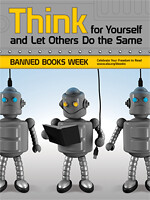James Morrow
At first I thought that The Philosopher's Apprentice would be a remake of Zen and the Art of Motorcycle Maintenance combined with Pygmalion, set on a lovely topical island. However, it soon morphed into a new take on The Island of Dr. Moreau, with a touch of it's most recent tribute, Jurassic Park. The novel then had a brief affair with I Robot before veering off into Stranger In A Strange Land and Night of the Living Dead, then suddenly became Juggernaut, taking a few cues from The Metamorphosis, making a short visit to Elie Wiesel's Night, returning to Heinlein's Stranger theme and ending, predictably, with a baby in a bookstore. There are a few plot twists to follow.
The book also give me a chance to expound my sophomore spiel about science fiction. A science fiction story must ask "What if?" "What if we colonize Mars." "What if a horrible disease kills all but a few people in the world?" What if something. Something, whatever question a story asks, should be non-trivial and the way it is asked and answered should not offend the reader's willingness to suspend disbelief. A good science fiction story will be carefully constructed so as not to trip on internal self contradiction. |
Morrow asks "Is a conscience innate or is it learned, and if learned, can it be taught to a postadolescent that never had the opportunity to be a child." He uses cloning, forced feeding of learning with mysterious projectors, and other, not well developed science fiction apparatus as tools to bring the novel to the point where that question can be asked. It is OK to be a bit sketchy about the science if, as in this case, the book is asking a non-technical question. A little pixie dust never hurt anyone without an engineering degree.
The plot twists take over the story, bringing in so many surprising developments that the fundamental ethical question is somewhat obscured. It does make for a page turner, though, and the book does return to that question again, sometimes answering yes and sometimes no and gives the philosophers favorite answer, "On the one hand - but on the other hand."
I became involved enough with the characters, particularly his version of Eliza Doolittle/Valentine Michael Smith, that I became somewhat upset with Morrow over some of the things that he had her, and her disciples doing. I also had a hard time believing that the authorities would ignore a conspiracy to create an army of zombies and send them to burn down a city in the middle of Maryland. I live in Maryland for cripes sake! You couldn't even do that in Louisiana, without raising a few eyebrows, even if you were the Governor's delinquent son in law.









